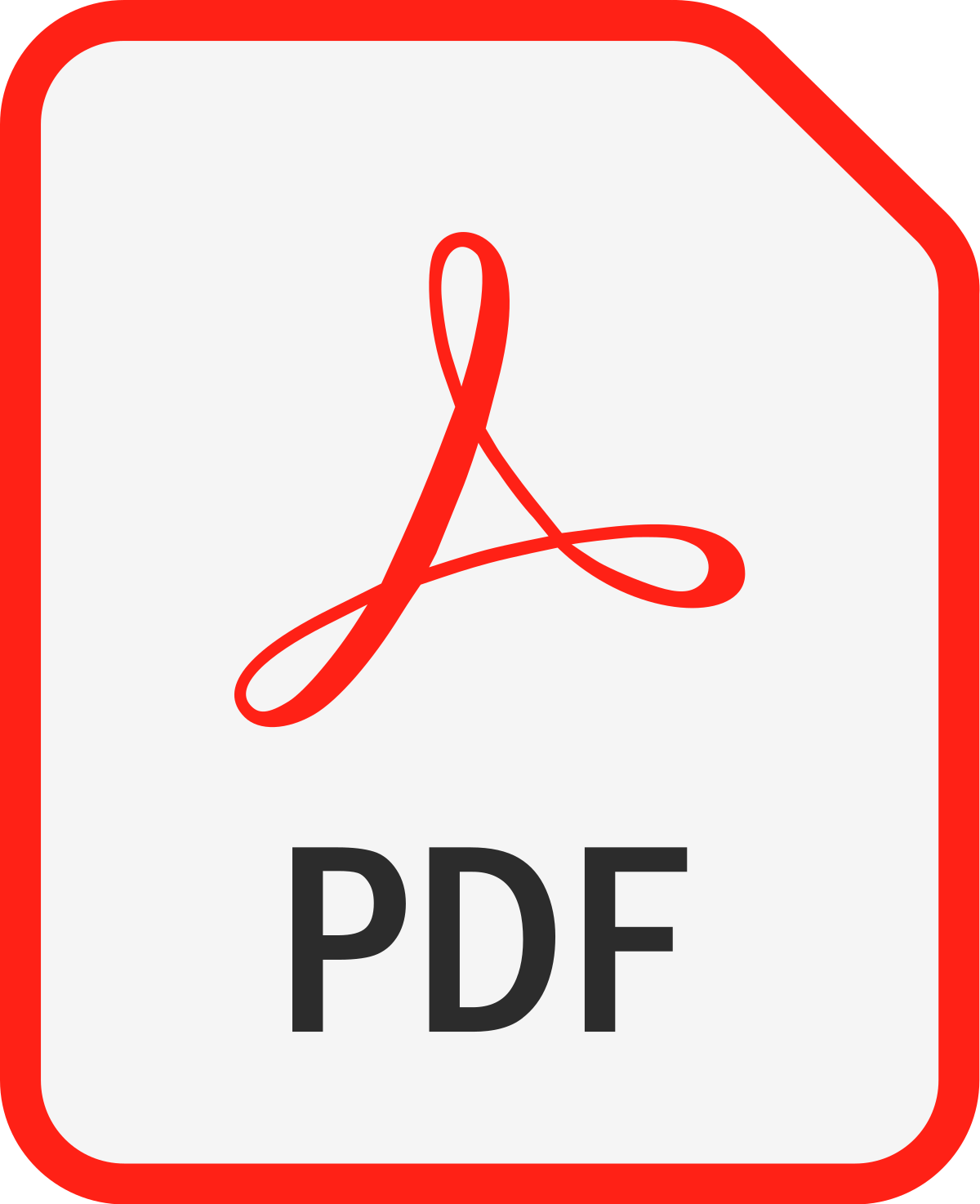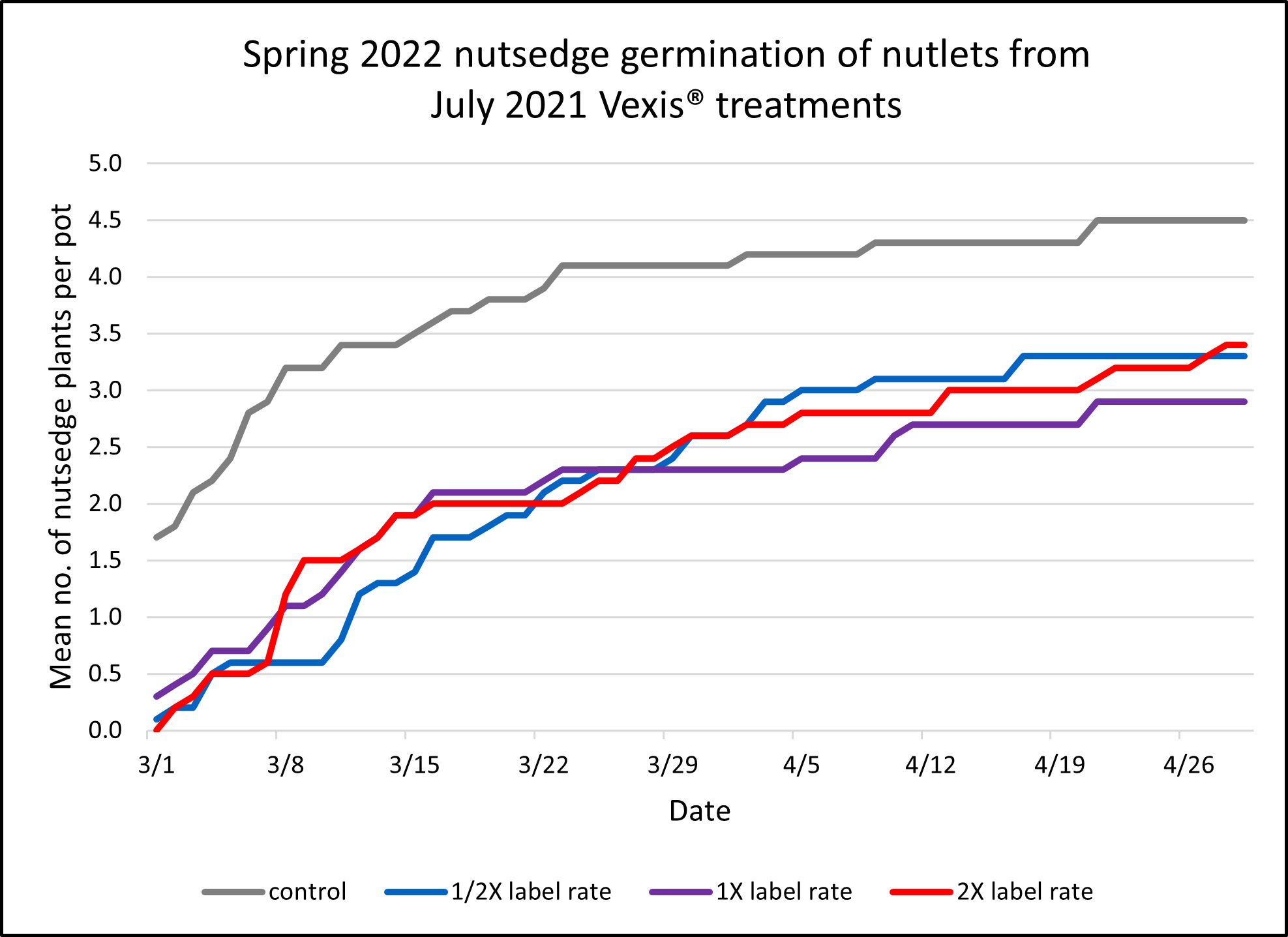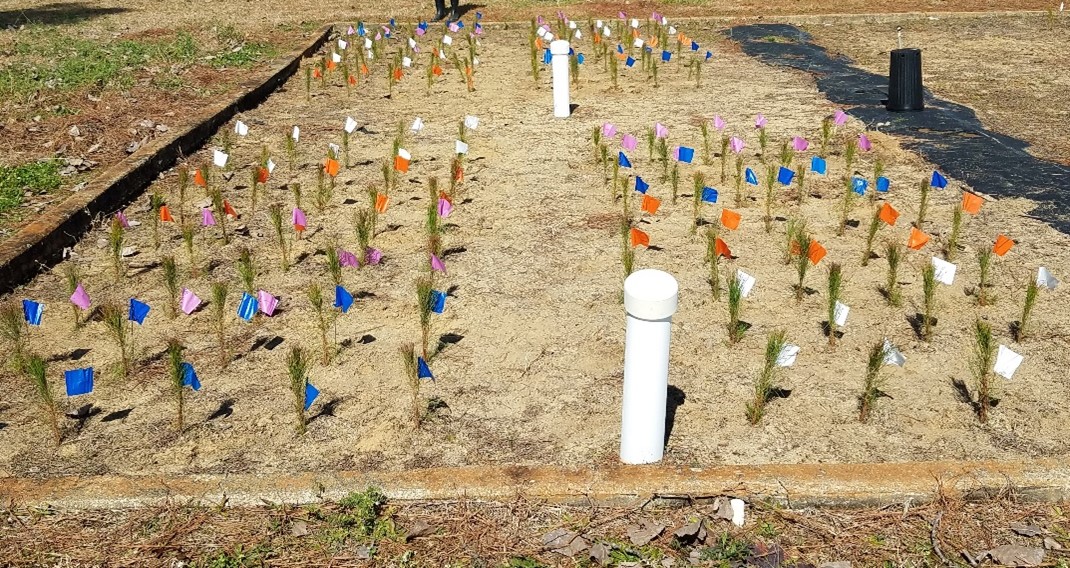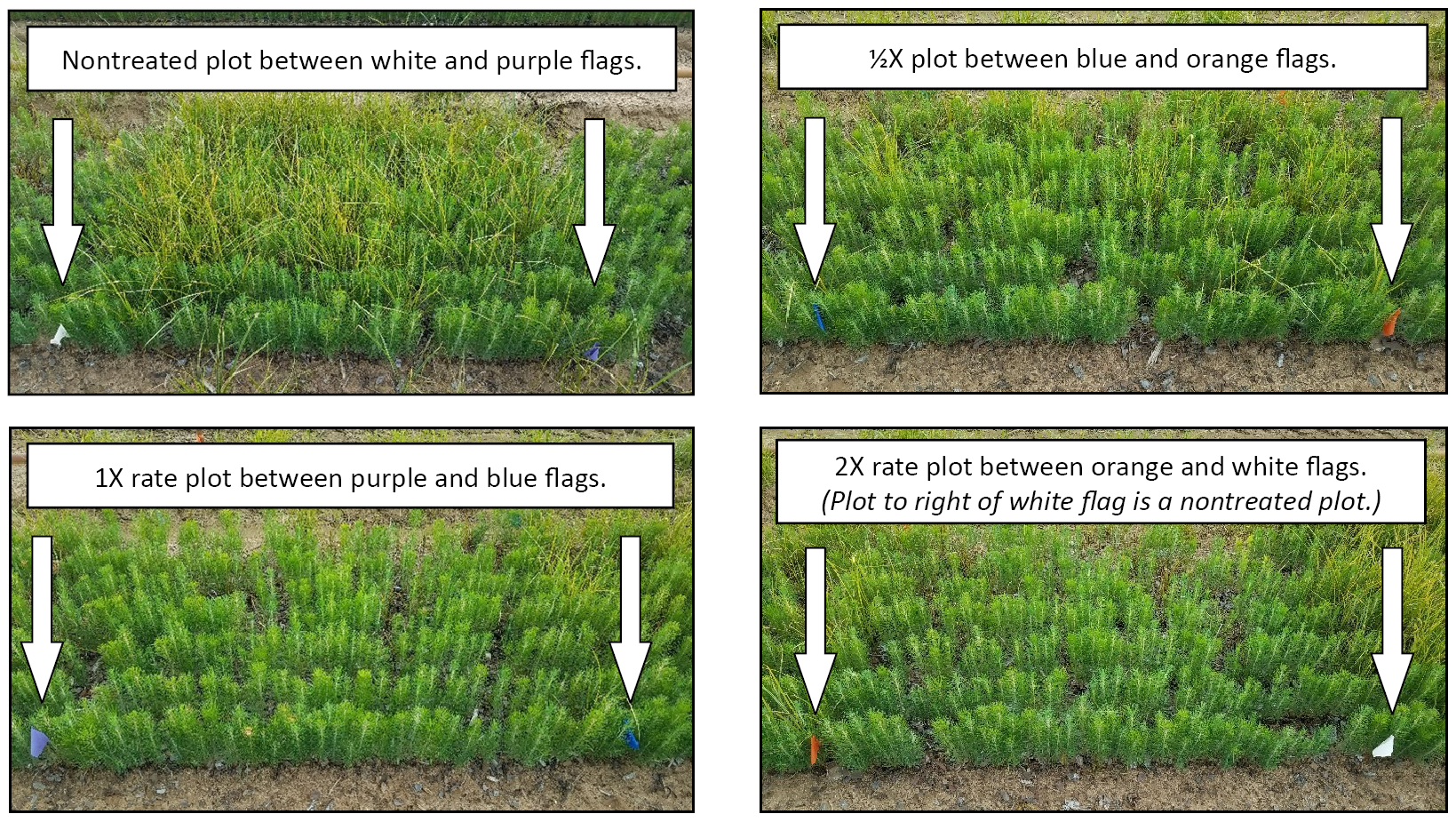Research Report 22-03 
The Efficacy of Pyrimisulfan on Nutsedge Control and the Tolerance of Loblolly and Slash Pine in Bareroot Seedling Beds
Nina Payne, Tom Stokes, Annakay Newell, Jeff Fields, and Russell Ayres
Table 1. Bareroot loblolly pine seedling characteristics treated with pyrimisulfan (Vexis®) at 8.5 weeks post-sowing on July 6, 2021.

Table 2. Bareroot slash pine seedling characteristics treated with pyrimisulfan (Vexis®) at 8.5 weeks
post-sowing on July 6, 2021.
 1Bold within a seedling characteristic indicates significant difference between that rate and control.
1Bold within a seedling characteristic indicates significant difference between that rate and control.
2Different letters within a seedling characteristic indicate significant differences in rates.

Figure 1. Germination over time of nutlets obtained from Vexis® treatment plots of July 2021.

Figure 2. Outplanting of loblolly pine seedlings from July 2021 Vexis® trial. Flag colors indicate
control (white), 1/2X rate (blue), 1X rate (purple), and 2X rate (orange).

Figure 3. Nutsedge growing in plots within the Vexis® trial area. Photos taken August 19, 2021,
6 weeks after treatment.

Figure 4. Nutsedge grown from nutlets collected from July 2021 Vexis® treatment plots. Nutlets
planted on February 11, 2022. Photo taken on March 11, 2022.
Introduction
In 1975, members of the Cooperative Forest Nursery Weed Control Project based at the School of Forestry at Auburn University tested a post-emergent herbicide (cyperquat) targeting nutsedge in pine seedling beds. In that original trial, cyperquat applied at two rates was shown to cause no injury to slash pine seedlings (South et al, 1976). Only a few years later, use of cyperquat as a herbicide was halted due to neurotoxin molecules in its makeup.
After forty-seven years and multiple trials of herbicides for nutsedge control, growers in the Southern Forest Nursery Management Cooperative are still contending with this weed in seedling beds. When nutsedge grows in places other than seedbeds (riser lines, ends of beds, roads, etc.) it can generally be contained with non-selective herbicides, but when it grows and spreads in seedling beds, control is much more difficult. Growers may resort to using non-selective herbicides in beds if nutsedge infestations have or will outgrow pine seedlings, accepting the loss of the pine seedlings in order to control the weed. Because of the growth habits of both yellow and purple nutsedge, hand-weeding often causes more problems than it solves, as removing only the visible above-ground portion of the weed leaves the nutlets and rhizomes to continue to grow for the next population (Patton and Weisenberger, 2019) (Yelverton, 2017).
Pyrimisulfan was discovered and developed in Japan and registered there in 2010 for use in rice paddies. One of the developers, Kumiai Chemical, partnered with PBI-Gordon Corporation in the United States to bring pyrimisulfan to market here. It was approved for registration by the EPA in December 2018 as Vexis® Herbicide Granular. This product is labeled for control of sedges (including purple and yellow nutsedge), broadleaf weeds, kylinga, and rush species and for use in turf, sod production, residential sites, recreational fields, rights-of-way, railroads and other non-production areas. Conifer nurseries are currently not listed as sites for use on its label.
Because the SFNMC had not tested this product, a trial was designed to quantify the tolerance of bareroot pine seedlings when treated with the product during the growing season. Visual assessments of nutsedge control were planned for the trial.
Methodology
In 2021, after identifying Vexis® as a possible herbicide to test, SFNMC staff contacted Dr. Paul Bartley of Auburn University’s Horticulture Department in the College of Agriculture. His experience in evaluating granular herbicides proved invaluable in recommending trial designs and methods of granular applications. At his suggestion, four treatments were included in the trial: a non-treated control, one-half, one, and two times the recommended label rate. Dr. Bartley noted that herbicide manufacturers typically call for testing of products at higher than labeled rates to quantify toxicity prior to proceeding with adding new application sites to labels.
This trial was installed at the Georgia Forestry Commission Nursery near Byromville, Georgia on July 6, 2021, when seedlings were 8.5 weeks old. Both loblolly and slash pine seedling beds were used. At the time of Vexis® application, no nutsedge was identified in the loblolly bed; however, the slash pine had a large quantity of nutsedge in the bed where plots were located. The plot size used was five feet long by four feet across (width of the seedling bed). A frame of that size was made with PVC pipe and placed on the plot for each granular application. Four replications were used in the loblolly pine bed (80 feet), while three were used in the slash pine bed (60 feet). Prior to travel to the field, quantities of Vexis® by rate were measured in the SFNMC laboratory, packaged in plastic containers, and labelled. In the field, application of the product was made as directed by Dr. Bartley, with a known amount of herbicide in each container to be distributed over the 4’ by 5’ plot. The herbicide was applied lightly by hand within each plot in vertical and horizontal paths to distribute the product as uniformly as possible. The Vexis® label calls for watering-in the granules within 48 hours of application, and the nursery received 0.62 inches of rain that evening and 0.31 inches the following day to fulfill this requirement.
In February 2022, all seedlings within a 9-inch by 4-foot counting frame placed in each plot were collected and transported to the SFNMC laboratory for measurements. Notes and photographs of nutsedge populations in each plot were also made. In addition to seedlings, nutlets from actively growing nutsedge plants within the slash pine bed were collected by hand from plots by rate. Soil (not treated with Vexis®) from a nearby nursery bed was collected and transported with the nutlets for planting and growing in the SFNMC greenhouse.
At the SFNMC lab and greenhouse, seedlings collected from each plot were counted for measures of bed density, then a 25-tree random sample from each plot was measured for seedling quality characteristics of shoot height, root collar diameter, and shoot and root biomass. Data from seedlings obtained from plots of each treatment (0, ½X, 1X, and 2X) were analyzed using Duncan’s Multiple Range test and Dunnett’s t-test at alpha = 0.05. Results are found in Tables 1 and 2.
Nutlets collected by treatment from nutsedge plants growing in plots were planted in 1 gallon pots in soil brought from the nursery, then grown in the greenhouse for three months. Five nutlets were planted in each pot, with ten pots of each treatment included. The purpose of this portion of the study was to determine if applications of Vexis® affect the germination and/or growth of nutsedge from nutlets. Results are seen in Figure 1.
To determine possible effects of Vexis® at outplanting, seedlings collected by replication and plot from loblolly and slash pine beds were planted on February 16, 2022, in an outplanting site on the Auburn University campus. Sets of ten seedlings of each rate (collected by replication in the nursery) were planted in blocks and initial measurements were made at planting (Figure 2). These seedlings will be monitored through the growing season for mortality and growth, then final measurements will be made at the end of the growing season. Data will be analyzed by Duncan’s Multiple Range test and Dunnett’s t-test to determine any negative effects of Vexis® treatments on loblolly and slash pine seedlings after one growing season in simulated field conditions.
Results
Loblolly pine:
Applications of Vexis® at one-half, one, and two times the recommended label rate resulted in no significant differences in seedling characteristics when treated seedlings were compared with non-treated control seedlings. It should be noted that no nutsedge was present in loblolly plots during the growing season.
Slash pine:
Applications of Vexis® at one-half, one, and two times the recommended label rate resulted in significant differences in measures of seedling height, root collar diameter, shoot mass, and root mass when comparing non-treated control seedlings to treated seedlings. Density of seedlings per square foot was not significantly different between any treatment plots and non-treated control plots.
The only negative effect quantified in analysis was in height of seedlings from the one-time-label rate plots compared to non-treated control plot seedlings. Control seedlings were 2.5 centimeters taller than treated seedlings at that rate. However, all seedlings within the trial beds were top-clipped several times during the growing season, so this numerical difference could be the result of other factors and may not be due to Vexis® treatment, especially considering that the other two Vexis® treatments did not display this difference.
Root collar diameters of treated seedlings at all rates were significantly larger than non-treated control seedlings, as was shoot mass. Root mass of seedlings treated at the one-time-label rate and the two-time-label rate was significantly greater than the root mass of either the control or the one-half-time label rate seedlings. Because nutsedge was controlled or eliminated in the plots receiving applications of Vexis®, pine seedlings did not have to compete for water, sunlight, and nutrients and were able to grow larger than those seedlings in control plots containing nutsedge.
Nutsedge:
In August 2021 and February 2022, visual inspection of plots within the slash pine bed showed distinct differences in the quantity and health of nutsedge there. Plots that were not treated with Vexis® showed the heaviest infestations, while treated plots contained varying amounts and damage of nutsedge. These can be seen in Figure 3.
Nutsedge grown in pots from nutlets collected from non-treated nutsedge plants were the first to germinate when compared to nutlets collected from Vexis®-treated plots. On average, this germination occurred approximately 2 weeks prior to germination of treated nutlets. The nutsedge growing from non-treated nutlets also displayed more vigor earlier the growing season than nutsedge from treated nutlets, growing faster with taller, wider blades in comparison. This can be seen in Figure 4. During the three months of growth, however, nutsedge from nutlets from treated plots eventually germinated and grew, showing that the effect of Vexis® is herbistatic in delaying germination and growth of the plant but not killing it.
Management Implications
These single trial results show that loblolly and slash pine are tolerant of pyrimisulfan formulated as Vexis®, but this is the first trial in which it has been tested in bareroot pine seedling beds. Until additional testing and analysis can be done, its use should be limited to only those sites listed on its label (which does not include conifer nurseries). Non-cropland sites including fence rows, roadside, ditches, and pipelines are among the areas listed, so the label does provide for its use on nursery property such as roads and ditches.
Further field trials in several bareroot nurseries in both loblolly and slash pine are planned, as is continued monitoring and analysis of the outplanting study established in February 2022.
Acknowledgements
Our thanks go to the managers and staff of the Georgia Forestry Commission nursery for their continued assistance in the project. Appreciation also goes to Dr. Eric Reasor, Southeast Research Scientist for PBI-Gordon, for his expertise and provision of herbicide samples, and to Dr. Paul Bartley, Assistant Professor in the Department of Horticulture at Auburn University for his guidance and assistance in designing this trial and instruction in applying Vexis®.
References
Brosnan, J. and G. Breeden. 2019. Postemergence weed control in warm-season turfgrass with a mixture of pyrimisulfan and penoxsulam. HortScience. 54(5).
Patton, A. and D. Weisenberger. 2019. Yellow nutsedge control. Purdue Extension AY-19-W. https://www.extension.purdue.edu/extmedia/ay/ay-19-w.pdf
Yelverton, F. 2017. Purple nutsedge. NC State Extension Publications. https://content.ces.ncsu.edu/purple-nutsedge.
Yoshimura, T., T. Ikeuchi, S. Ohno, S. Asakura and Y. Hamada. 2013. Research and development of a novel rice herbicide, pyrimisulfan. Journal of Pesticide Science. 38(3), 171-172.
South, D., R. Crowley and D. Gjerstad. 1976. Herbicide weed control results in pine seedbeds, pp. 95-106. In Proceedings, Southeastern Area Nurserymens’ Conference, Charleston, South Carolina.
PBI-Gordon Corporation. Vexis® herbicide Granular label. Retrieved from: https://www.cdms.net/ldat/ldGAU003.pdf




